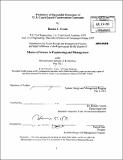| dc.contributor.advisor | Ricardo Valerdi. | en_US |
| dc.contributor.author | Evans, Dennis C. (Dennis Christopher) | en_US |
| dc.contributor.other | System Design and Management Program. | en_US |
| dc.date.accessioned | 2011-12-09T21:22:32Z | |
| dc.date.available | 2011-12-09T21:22:32Z | |
| dc.date.copyright | 2011 | en_US |
| dc.date.issued | 2011 | en_US |
| dc.identifier.uri | http://hdl.handle.net/1721.1/67551 | |
| dc.description | Thesis (S.M. in Engineering and Management)--Massachusetts Institute of Technology, Engineering Systems Division, System Design and Management Program, 2011. | en_US |
| dc.description | Cataloged from PDF version of thesis. | en_US |
| dc.description | Includes bibliographical references (p. 117-118). | en_US |
| dc.description.abstract | The U. S. federal government contracts over five hundred billion dollars in goods and services each year. Traditionally, these contracts are awarded on the basis of a combination of a contractor's proposed cost, quality, technical capability and demonstrated past performance. While all valid and important comparators, the overall quality and customer satisfaction achieved at the completion of contracts awarded on these bases remains highly variable from contract-to-contract. This thesis examines potential reasons for the variability of these results and further proposes additional factors for contract evaluation and award that should improve the chances for successful contract outcomes. Twenty four randomly selected and recently completed U. S. Coast Guard construction contracts were used as the basis for study. The documented performance information for each contract was compared against contract demographic information in a search for correlations that are predictive of the likelihood of a high level of contract satisfaction. Contract performance ratings, contract timeliness and contract on-budget performance were compared to overall contractor annual revenue, total contractor employees, the relative contract size and a contractor's revenue per employee. The main finding is that total contractor revenue, relative contract size (higher is better) and contractor revenue per employee (higher is better) are reliable predictors of performance and should be considered as relevant source selection factors for negotiated contracts. Capable small contractors should be selected not simply as a matter of conformance to a social program, but because the expected results are higher. In addition, the following recommendations apply in order to maximize the probability of positive performance outcomes on U. S. Coast Guard construction contracts: 1) Improve the collection and utilization of past performance data. 2) Minimize sealed-low bid contracting. 3) Maximize contracts by negotiation. 4) Maximize the usage of small businesses, above the "micro-small" level. | en_US |
| dc.description.statementofresponsibility | by Dennis C. Evans. | en_US |
| dc.format.extent | 122 p. | en_US |
| dc.language.iso | eng | en_US |
| dc.publisher | Massachusetts Institute of Technology | en_US |
| dc.rights | M.I.T. theses are protected by
copyright. They may be viewed from this source for any purpose, but
reproduction or distribution in any format is prohibited without written
permission. See provided URL for inquiries about permission. | en_US |
| dc.rights.uri | http://dspace.mit.edu/handle/1721.1/7582 | en_US |
| dc.subject | Engineering Systems Division. | en_US |
| dc.subject | System Design and Management Program. | en_US |
| dc.title | Predictors of successful outcomes of U.S. Coast Guard construction contracts | en_US |
| dc.type | Thesis | en_US |
| dc.description.degree | S.M.in Engineering and Management | en_US |
| dc.contributor.department | System Design and Management Program. | en_US |
| dc.contributor.department | Massachusetts Institute of Technology. Engineering Systems Division | |
| dc.identifier.oclc | 761391095 | en_US |
